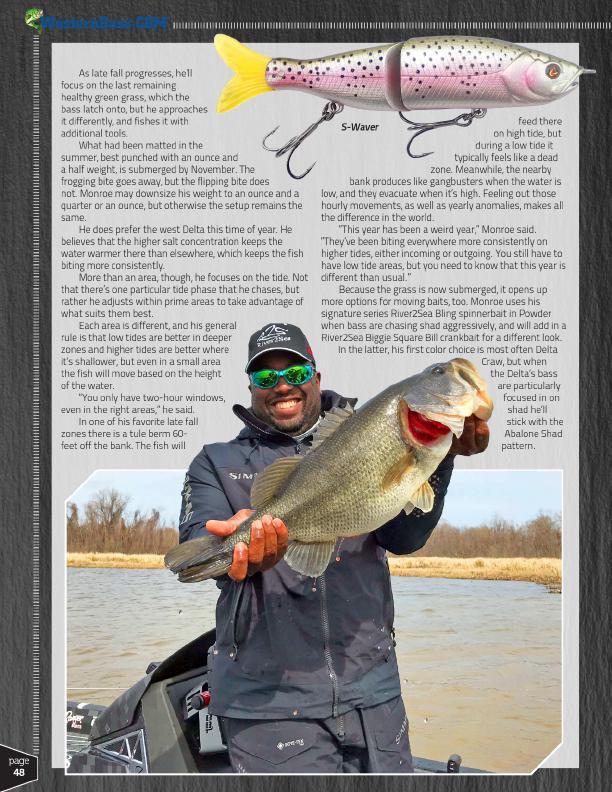
Winter 2021
®
As late fall progresses, he’ll focus on the last remaining healthy green grass, which the bass latch onto, but he approaches it differently, and fishes it with additional tools.
What had been matted in the summer, best punched with an ounce and a half weight, is submerged by November. The frogging bite goes away, but the flipping bite does not. Monroe may downsize his weight to an ounce and a quarter or an ounce, but otherwise the setup remains the same.
He does prefer the west Delta this time of year. He believes that the higher salt concentration keeps the water warmer there than elsewhere, which keeps the fish biting more consistently.
More than an area, though, he focuses on the tide. Not that there’s one particular tide phase that he chases, but rather he adjusts within prime areas to take advantage of what suits them best.
Each area is different, and his general rule is that low tides are better in deeper zones and higher tides are better where it’s shallower, but even in a small area the fish will move based on the height of the water.
“You only have two-hour windows, even in the right areas,” he said.
In one of his favorite late fall zones there is a tule berm 60- feet off the bank. The fish will
S-Waver
feed there on high tide, but
during a low tide it
typically feels like a dead
zone. Meanwhile, the nearby
bank produces like gangbusters when the water is
low, and they evacuate when it’s high. Feeling out those
hourly movements, as well as yearly anomalies, makes all
the difference in the world.
“This year has been a weird year,” Monroe said.
“They’ve been biting everywhere more consistently on
higher tides, either incoming or outgoing. You still have to
have low tide areas, but you need to know that this year is
different than usual.”
Because the grass is now submerged, it opens up
more options for moving baits, too. Monroe uses his
signature series River2Sea Bling spinnerbait in Powder
when bass are chasing shad aggressively, and will add in a
River2Sea Biggie Square Bill crankbait for a different look.
In the latter, his first color choice is most often Delta
Craw, but when
the Delta’s bass
are particularly
focused in on
shad he’ll
stick with the
Abalone Shad
pattern.
page 48